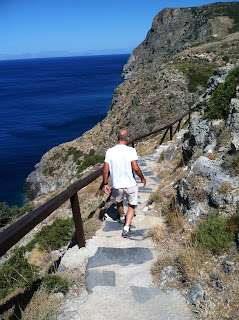One of the most beautiful such churches is Saint Sophia in the Cave, in Mylopotamos, Kythera. I saw the posters all over the storefronts of the island but couldn't fathom from the faint photo what to expect.
The impossible blue of the sea is often part of the surrounding scape.
Stelios and I headed out towards the location of the church with some apprehension. Some of the roads can be pretty frightening; narrow, windy and on cliffsides without any guardrails for protection.Sure enough, the road to the cave was one of these roads. I'm happy to report that since it was early in the day, the traffic was thin to none! Nevertheless, the going was slow and careful.
When we arrived on the site of several parked pars on the road, we realized this had to be it. We saw the entrance over the side of the cliff and took a look. A long pathway had been built into the cliff that led to the cave.
Icon of Saint Sophia and her three daughters who it is said were persecuted for their Christian faith. They found refuge in a cave where they were eventually discovered and killed.
The templon
Detail of Saint Sophia
The shed at the entrance of the cave.
Above are closeups and details of various saints depicted on the templon.
Exploring the Cave.




This is one of the most spectacular caves I've ever seen, not because it is huge or grand but because it has not been significantly altered. The history of the church in the cave is intriguing and the temple that I saw when I first entered the cave created a feeling of mystery and a connection with history.


























No comments:
Post a Comment